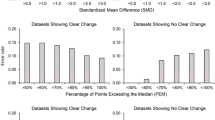Abstract
There is a common misconception in applied research that generalizations from a study to a specific client can only be made with a large sample size. In single-case design research, however, generalizations are made from a line of replication studies rather than from a single large-N study. In this brief tutorial, we summarize how generalizations are made from single-case design research, and provide a model elevator speech to assist behavior analysts in talking about single-case design research with others.

Similar content being viewed by others
Notes
We should note that generality also has another meaning in applied behavior analysis. Baer, Wolf, and Risley (1968) use generality to refer to the durability and breadth of the effects of a particular intervention implementation.
Birnbrauer (1981) proposed a different way of thinking about generality, in which its basis is the functional difference between the behavior’s controlling variables during baseline and intervention, rather than participant or setting characteristics. Birnbrauer stated, “We should look for similarities in baseline conditions, the functional relations that appear to be operative during those pretreatment conditions, and the functional changes that implementation of treatment entailed for previous subjects” (p. 126). We do not disagree with this approach to generality. However, it can only be applied when experimental articles include such information; most do not. In addition, the larger scientific community still discusses generality in terms of differences between participants, settings, and other variables across studies. Thus, this is the framework we use in the current article.
A line of research generally produces a large N, but it is the various systematic replication conditions that ultimately enhance generalization and not the large N itself.
References
Baer, D. M., Wolf, M. M., & Risley, T. R. (1968). Some current dimensions of applied behavior analysis. Journal of Applied Behavior Analysis, 1(1), 91–97. https://doi.org/10.1901/jaba.1968.1-91.
Bailey, J. S., & Burch, M. R. (2010). 25 essential skills & strategies for the professional behavior analyst. Routledge.
Bailey, J. S., & Burch, M. R. (2018). Research methods in applied behavior analysis (2nd ed.). Routledge.
Barlow, D. H., Nock, M. K., & Hersen, M. (2009). Single case experimental designs: Strategies for studying behavior change (3rd ed.) Pearson.
Birnbrauer, J. S. (1981). External validity and experimental investigation of individual behaviour. Analysis and Intervention in Developmental Disabilities, 1(2), 117–132. https://doi.org/10.1016/0270-4684(81)90026-4.
Branch, M. N., & Pennypacker, H. S. (2013). Generality and generalization of research findings. In G. J. Madden (Ed.), Handbook of behavior analysis (Vol. 1, pp. 151–175). American Psychological Association.
Carr, E. G., & Durand, V. M. (1985). Reducing behavior problems through functional communication training. Journal of Applied Behavior Analysis, 18(2), 111–126. https://doi.org/10.1901/jaba.1985.18-111.
Fisher, W. W., Luczynski, K. C., Blowers, A. P., Vosters, M. E., Pisman, M. D., Craig, A. R., Hood, S. A., Machado, M. A., Lesser, A. D., & Piazza, C. C. (2020). A randomized clinical trial of a virtual-training program for teaching applied-behavior-analysis skills to parents of children with autism spectrum disorder. Journal of Applied Behavior Analysis, 53(4), 1856–1875. https://doi.org/10.1002/jaba.778.
Gerow, S., Hagan-Burke, S., Rispoli, M., Gregori, E., Mason, R., & Ninci, J. (2018). A systematic review of parent-implemented functional communication training for children with ASD. Behavior Modification, 42(3), 335–363. https://doi.org/10.1177/0145445517740872.
Hagopian, L. P. (2020). The consecutive controlled case series: Design, data-analytics, and reporting methods supporting the study of generality. Journal of Applied Behavior Analysis, 53(2), 596–619. https://doi.org/10.1002/jaba.691.
Heiman, G. W. (1995). Research methods in psychology. Houghton Mifflin.
Hernández, V., Fernand, J. K., Vollmer, T. R., & Slocum, S. K. (2018). Retrospective analysis of changes in response topographies of escape-maintained aggressive behavior during functional analyses. Journal of Applied Behavior Analysis, 51(3), 521–527. https://doi.org/10.1002/jaba.464.
Johnston, J. M., Pennypacker, H. S., & Green, G. (2020). Strategies and tactics of behavioral research and practice (4th ed.). Routledge.
Kazdin, A. E. (2011). Single-case research designs: Methods for clinical and applied settings (2nd ed.). Oxford University Press.
Ledford, J. R., & Gast, D. L. (Eds.). (2018). Single case research methodology: Applications in special education and behavioral sciences (3rd ed.). Routledge.
Lipschultz, J. L., Wilder, D. A., Ertel, H., & Enderli, A. (2018). The effects of high-p and low-p instruction similarity on compliance among young children. Journal of Applied Behavior Analysis, 51(4), 866–878. https://doi.org/10.1002/jaba.482.
Mancil, G. R. (2006). Functional communication training: A review of the literature related to children with autism. Education and Training in Developmental Disabilities, 41(3), 213–224.
Meany-Daboul, M. G., Roscoe, E. M., Bourret, J. C., & Ahearn, W. H. (2007). A comparison of momentary time sampling and partial-interval recording for evaluating functional relations. Journal of Applied Behavior Analysis, 40(3), 501–514. https://doi.org/10.1901/jaba.2007.40-501.
Mirenda, P. (1997). Supporting individuals with challenging behavior through functional communication training and AAC: Research review. Augmentative and Alternative Communication, 13(4), 207–225. https://doi.org/10.1080/07434619712331278048.
Moore, K., Delaney, J. A., & Dixon, M. R. (2007). Using indices of happiness to examine the influence of environmental enhancements for nursing home residents with Alzheimer’s disease. Journal of Applied Behavior Analysis, 40(3), 541–544. https://doi.org/10.1901/jaba.2007.40-541.
Purswell, K. E., & Ray, D. C. (2014). Research with small samples: Considerations for single case and randomized small group experimental designs. Counseling Outcome Research and Evaluation, 5(2), 116–126. https://doi.org/10.1177/2150137814552474.
Sidman, M. (1960). Tactics of scientific research. Basic Books.
Spata, A. (2003). Research methods: Science and diversity. Wiley.
Acknowledgement
We thank April Kisamore for her assistance during the early stage of this project.
Author information
Authors and Affiliations
Corresponding author
Ethics declarations
Ethical approval
This is a discussion article; no ethical approval was required.
Informed consent
Informed consent was not applicable.
Conflict of interest
The authors declare that they have no conflict of interest.
Additional information
Publisher’s Note
Springer Nature remains neutral with regard to jurisdictional claims in published maps and institutional affiliations.
Rights and permissions
About this article
Cite this article
Walker, S.G., Carr, J.E. Generality of Findings From Single-Case Designs: It’s Not All About the “N”. Behav Analysis Practice 14, 991–995 (2021). https://doi.org/10.1007/s40617-020-00547-3
Accepted:
Published:
Issue Date:
DOI: https://doi.org/10.1007/s40617-020-00547-3




